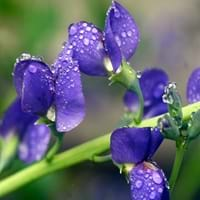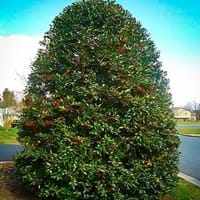Life Span
Perennial
Perennial
Type
Shrub
Broadleaf Evergreen
Origin
North America, United States, North-Central United States, Central United States, Canada
Hybrid origin
Types
Blue False Indigo
White False Indigo
Not Available
Number of Varieties
Not Available
Habitat
gardens, Grassland, Warmer regions
Subtropical climates, Woodland Garden Secondary, Woodlands
USDA Hardiness Zone
2-8
6-9
AHS Heat Zone
8-1
Not Available
Sunset Zone
A1, A2, A3, 1a, 1b, 2a, 2b, 3a, 3b, 4, 5, 6, 7, 8, 9
21,22
Habit
Oval or Rounded
Pyramidal
Flower Color
Purple
White
Flower Color Modifier
Not Available
Bicolor
Fruit Color
Light Green
Red, Crimson
Leaf Color in Spring
Light Green, Gray Green, Gray
Green, Dark Green
Leaf Color in Summer
Light Green, Gray Green, Gray
Dark Green
Leaf Color in Fall
Light Green, Gray Green, Gray
Dark Green
Leaf Color in Winter
Not Available
Dark Green
Plant Season
Summer, Fall
Spring, Summer, Fall, Winter
Sunlight
Full Sun, Partial Sun, Partial shade
Full Sun, Partial Sun, Partial shade, Full Shade
Type of Soil
Loam, Sand
Clay, Loam, Sand
The pH of Soil
Neutral, Alkaline
Acidic, Neutral
Soil Drainage
Well drained
Average
Bloom Time
Summer, Late Summer, Early Fall
Spring
Tolerances
Drought
Drought, Soil Compaction
Where to Plant?
Ground, Pot
Ground
How to Plant?
Seedlings, Stem Planting
Rooted stem cutting, Stem Cutting, stem tip cuttings
Plant Maintenance
Medium
Medium
Watering Requirements
Average Water Needs
Average Water Needs, Do not water frequently
In Summer
Lots of watering
Lots of watering
In Spring
Moderate
Moderate
In Winter
Average Water
Average Water
Soil pH
Neutral, Alkaline
Acidic, Neutral
Soil Type
Loam, Sand
Clay, Loam, Sand
Soil Drainage Capacity
Well drained
Average
Sun Exposure
Full Sun, Partial Sun, Partial shade
Full Sun, Partial Sun, Partial shade, Full Shade
Pruning
Remove damaged leaves, Remove dead branches, Remove dead leaves
Remove damaged leaves, Remove dead branches, Remove dead leaves
Fertilizers
All-Purpose Liquid Fertilizer
All-Purpose Liquid Fertilizer, Apply N-P-K
Pests and Diseases
Red blotch
Leafminers, Mites, Nematodes, Red blotch, Root rot, Tar spot
Plant Tolerance
Drought
Drought
Flowers
Showy
Insignificant
Flower Petal Number
Single
Single
Fragrant Bark/Stem
Yes
No
Foliage Texture
Fine
Medium
Foliage Sheen
Matte
Glossy
Self-Sowing
Not Available
No
Attracts
Not Available
Birds
Allergy
Not Available
Diarrhea, Mildly Toxic, Vomiting
Aesthetic Uses
Showy Purposes
Cottage Garden, Showy Purposes, Used for making hedges
Beauty Benefits
Not Available
Not Available
Environmental Uses
Air purification
Air purification
Medicinal Uses
Not Available
Not Available
Part of Plant Used
Whole plant
Fruits
Other Uses
Used as Ornamental plant
Food for animals, Used for Landscaping
Used As Indoor Plant
No
No
Used As Outdoor Plant
Yes
Yes
Garden Design
Foundation, Mixed Border, Rock Garden, Wall
Feature Plant, Foundation, Hedges, Mixed Border, Screening, Wind Break
Botanical Name
AMORPHA canescens
ILEX 'Nellie Stevens'
Common Name
False Indigo
Nellie Stevens Holly
In Hindi
इंडिगो
Nellie Stevens Holly
In German
falsches Indigo
Nellie Stevens Holly
In French
faux Indigo
Nellie Stevens Holly
In Spanish
Falso Indigo
Nellie Stevens Holly
In Greek
Λάθος Indigo
Nellie Stevens Holly
In Portuguese
false Indigo
Nellie Stevens Holly
In Polish
fałsz Indigo
Nellie Stevens Holly
In Latin
falsum indicum
Nellie Stevens Holly
Phylum
Magnoliophyta
Not Available
Class
Not Available
Not Available
Order
Fabales
Aquifoliales
Family
Fabaceae
Aquifoliaceae
Clade
Angiosperms, Eudicots, Rosids
Angiosperms, Eudicots
Tribe
Not Available
Not Available
Subfamily
Not Available
Not Available
Number of Species
Not Available
Season and Care of False Indigo and Nellie Stevens Holly
Season and care of False Indigo and Nellie Stevens Holly is important to know. While considering everything about False Indigo and Nellie Stevens Holly Care, growing season is an essential factor. False Indigo season is Summer and Fall and Nellie Stevens Holly season is Summer and Fall. The type of soil for False Indigo is Loam, Sand and for Nellie Stevens Holly is Clay, Loam, Sand while the PH of soil for False Indigo is Neutral, Alkaline and for Nellie Stevens Holly is Acidic, Neutral.
False Indigo and Nellie Stevens Holly Physical Information
False Indigo and Nellie Stevens Holly physical information is very important for comparison. False Indigo height is 60.00 cm and width 120.00 cm whereas Nellie Stevens Holly height is 460.00 cm and width 300.00 cm. The color specification of False Indigo and Nellie Stevens Holly are as follows:
False Indigo flower color: Purple
False Indigo leaf color: Light Green, Gray Green and Gray
Nellie Stevens Holly flower color: White
- Nellie Stevens Holly leaf color: Green and Dark Green
Care of False Indigo and Nellie Stevens Holly
Care of False Indigo and Nellie Stevens Holly include pruning, fertilizers, watering etc. False Indigo pruning is done Remove damaged leaves, Remove dead branches and Remove dead leaves and Nellie Stevens Holly pruning is done Remove damaged leaves, Remove dead branches and Remove dead leaves. In summer False Indigo needs Lots of watering and in winter, it needs Average Water. Whereas, in summer Nellie Stevens Holly needs Lots of watering and in winter, it needs Average Water.





